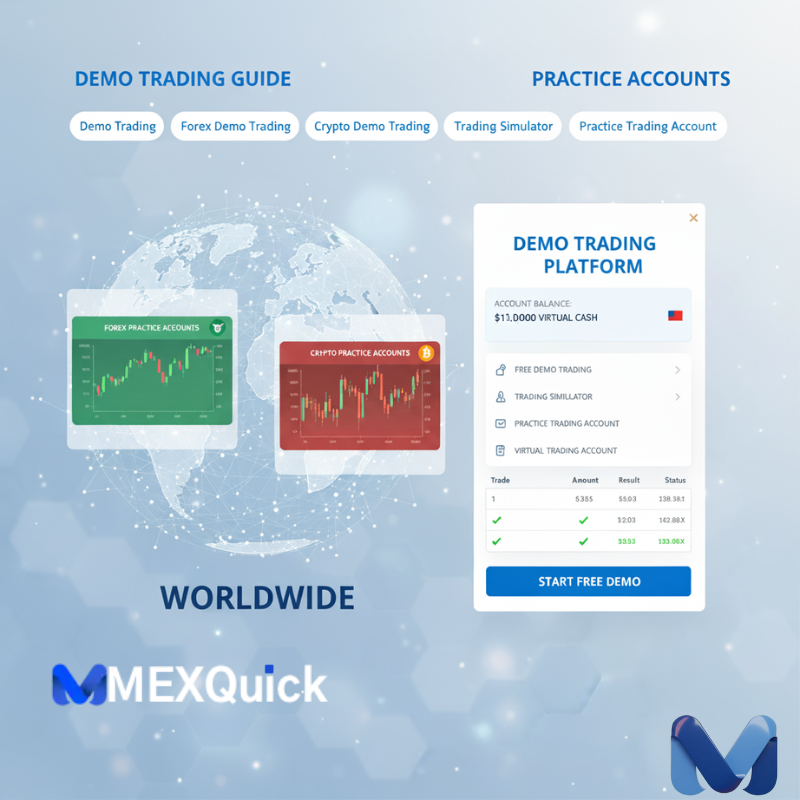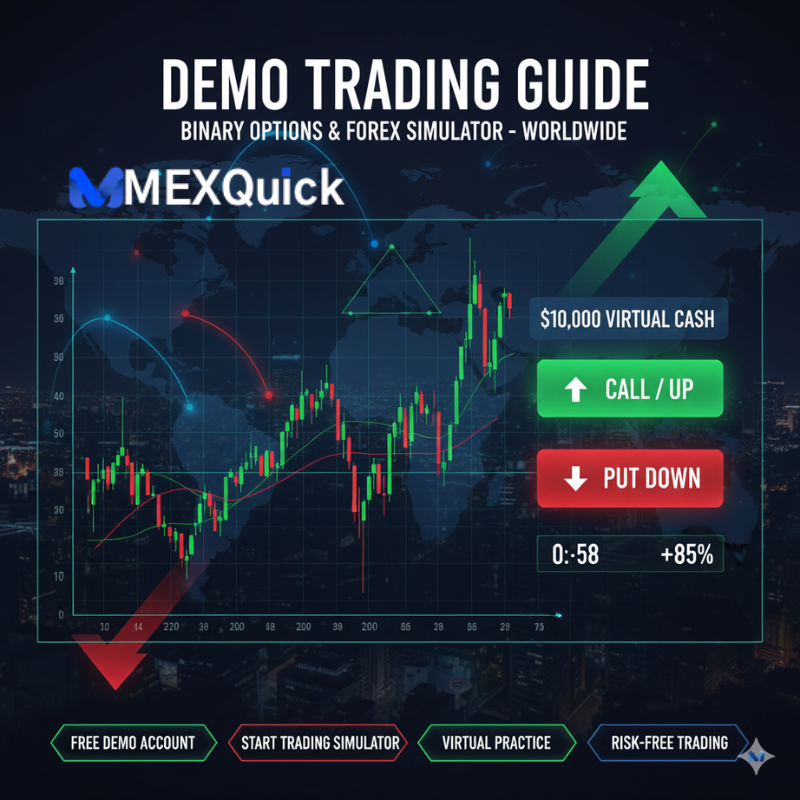Demo Trading Guide Master Forex & Crypto with Free Practice Accounts

I remember the first time I placed a trade. My heart was pounding, my palms were sweaty, and I was convinced every minor price fluctuation was a sign of impending doom. Sound familiar? If you’re new to forex or crypto trading, that feeling is universal. The market is a wild ocean, and jumping in without a life jacket is a recipe for disaster. That’s where a demo trading guide like this becomes your most valuable asset. Think of a demo trading account as your financial flight simulator. It lets you take the controls of a multi-million dollar portfolio without risking a single cent of your hard-earned money. You can crash, burn, and learn from your mistakes in a consequence-free environment. In this guide, I’ll walk you through everything you need to know about demo trading, from choosing the best trading simulator to developing the discipline needed to succeed with real money. Let’s turn that nervous excitement into confident execution.
What is Demo Trading? Your Risk-Free Training Ground
At its core, demo trading is the practice of trading financial markets using virtual money instead of real capital. It’s a simulation that replicates a live trading environment in almost every way. When you open a free demo trading account with a broker, they give you a practice account loaded with a specific amount of virtual cash—often $10,000, $50,000, or even $100,000. You then use this virtual money to place trades on live market prices. The goal isn’t to get rich on paper profits. The real goal is to:
Learn the mechanics of your chosen demo trading platform.
Test trading strategies without financial risk.
Understand how leverage, margin, and order types work.
Develop emotional control and trading discipline.

How Forex and Crypto Demo Accounts Actually Work
It’s crucial to understand that a high-quality demo account isn’t a separate, fake market. It’s a mirror of the real world.
Here’s the magic behind the curtain:
Real-Time Data: The prices you see for EUR/USD, Bitcoin, or Apple stock are the exact same prices flowing into live trader accounts. The data feed is identical.
Virtual Currency: The only thing that’s “fake” is the money in your account balance. This allows you to execute trades as if you were using real money.
Full Platform Access: You typically have access to all the tools and features of the platform: technical indicators, charting tools, economic calendars, and different order types (market, limit, stop-loss).
Time-Limited: Most brokers offer demo accounts that expire after a certain period (usually 30 to 90 days). This encourages you to learn and then transition to a live account.
Key Differences: Forex Demo vs. Crypto Demo Trading
| Feature | Forex Demo Trading | Crypto Demo Trading |
|---|---|---|
| Assets | Currency Pairs (e.g., EUR/USD) | Cryptocurrencies (e.g., BTC/USD, ETH/USDT) |
| Market Hours | 24/5 (Closed weekends) | 24/7 |
| Common Platforms | MetaTrader 4 (MT4), MetaTrader 5 (MT5), cTrader | Exchange-native platforms, MT5, specialized crypto simulators |
| Focus | Leverage, margin, interest rates (swaps) | Volatility, altcoin diversity, wallet management |
Best Free Demo Trading Platforms Worldwide in 2024

Choosing the right demo trading platform is like choosing a good gym—you need one with the equipment you’ll actually use. Here are my top picks for forex demo trading and crypto demo trading.
Top Forex Demo Trading Platforms
MexQuick: A standout choice for traders seeking a powerful and intuitive demo trading experience. MexQuick’s platform combines advanced charting tools with an incredibly user-friendly interface, making it ideal for both beginners and experienced traders looking to test strategies. Their demo account provides seamless access to real-time forex markets with instant execution. Why it’s great: Excellent educational resources integrated directly into the platform, making it more than just a simulator but a true learning hub.
MetaTrader 4 (MT4) / MetaTrader 5 (MT5): The industry standard. Almost every forex broker offers an MT4 or MT5 demo account. It’s powerful, supports automated trading (Expert Advisors), and has a massive community. Brokers to check: IC Markets, Pepperstone, FXPro.
cTrader: Known for its clean, modern interface and superior charting. If you’re a visual trader who dislikes cluttered screens, cTrader is a fantastic choice. Brokers to check: IC Markets, FXOpen.
TradingView: While primarily a charting platform, TradingView’s trading simulator (Paper Trading) is seamlessly integrated. You can develop a strategy on beautiful charts and test it instantly without switching apps.
Top Crypto Demo Trading Platforms
MexQuick: Expanding its excellence into the crypto space, MexQuick offers a comprehensive crypto demo trading environment. It’s perfect for traders who want to practice trading major cryptocurrencies like Bitcoin and Ethereum in a risk-free setting that mirrors the live market. The platform is designed for clarity and ease of use, reducing the learning curve for crypto newcomers. Why it’s great: The ability to practice both forex and crypto on a single, unified platform is a significant advantage for multi-asset traders.
Bybit Demo Trading: Bybit offers a superb demo trading environment for perpetual contracts and derivatives. It’s a favorite among crypto traders for its user-friendly interface and robust features. The demo account comes pre-loaded with up to 100,000 USDT.
Binance Demo Trading (Spot & Futures): The world’s largest crypto exchange has a built-in virtual trading account for both spot and futures markets. It’s perfect for getting familiar with the Binance ecosystem.
Phemex Demo Mode: Phemex provides a straightforward demo mode that’s excellent for beginners wanting to practice contract trading with zero risk.
Your Step-by-Step Guide to Using a Practice Trading Account
Don’t just randomly click buttons. Follow this structured approach to get the most out of your demo trading experience.
Step 1: Define Your Learning Goal
Before you start, ask yourself: “What do I want to achieve?” Is it mastering a specific strategy? Understanding leverage? Becoming proficient on a new platform? Write it down.
Step 2: Choose a Platform and Open Your Account
Select one of the platforms mentioned above. The sign-up process is usually quick and requires only an email address.
Step 3: Familiarize Yourself with the Interface
Spend 30 minutes clicking on everything. Find the order window, the charting tools, the account history tab. Know where everything is located.
Step 4: Develop and Test a Simple Strategy
Start with a basic strategy. For example, “I will only buy if the price crosses above the 50-day moving average and the RSI is below 70.” Backtest this strategy on historical data, then forward-test it in your demo account with live data.
Step 5: Treat the Virtual Money Like Real Money
This is the golden rule of demo trading. If you have a $10,000 demo account, don’t risk $5,000 on one trade. Use proper position sizing as if it were your real life savings. This builds crucial risk management habits.
Step 6: Keep a Trading Journal
Record every trade: the reason for entry, the reason for exit, the outcome, and, most importantly, your emotions. Review this journal weekly to identify patterns in your behavior.
The Double-Edged Sword: Advantages and Limitations of Demo Trading
Advantages (The Pros)
Zero Financial Risk: The biggest benefit. Learn from catastrophic mistakes without the catastrophic losses.
Platform Proficiency: Become a power user of your trading software before real money is on the line.
Strategy Validation: Prove that your trading idea has an edge before committing capital.
Confidence Building: Success in a simulated environment builds the confidence needed to execute in live markets.
Limitations (The Cons You MUST Understand)
Lack of Emotional Pressure: It’s easy to be disciplined with virtual money. The real test comes when fear and greed enter the picture with your own capital.
Unrealistic Execution: Some demo accounts may have perfect, instant order execution, which isn’t always the case in live markets (especially during high volatility).
Complacency Risk: It’s possible to get stuck in “demo mode” forever, avoiding the necessary leap to live trading.
The Final Leap: Transitioning from Demo to Live Trading
This is the most critical step. Moving from a practice trading account to a live account is a psychological jump. Here’s how to make it smoothly.
Achieve Consistent Profitability on Demo: This doesn’t mean you never have a losing trade. It means that over a period of 2-3 months, your demo account is steadily growing.
Start Small with Live Capital: When you go live, do NOT deposit the amount you were trading on demo. Start with a small, affordable amount that you are 100% comfortable losing. This reduces emotional pressure.
Keep the Same Strategy: Use the exact same strategy and risk management rules that made you successful on demo. The only thing that has changed is the money’s reality.
Expect a Learning Curve: You will likely feel nerves on your first live trades. This is normal. Stick to your plan, and the discipline you built in demo trading will see you through.
Conclusion: Your Actionable Insights for Trading Success
Let’s be real: demo trading isn’t the exciting part of trading. The excitement is in making real profits. But just like a pilot wouldn’t skip simulator training, you shouldn’t skip this essential phase.
Your Action Plan:
Today: Choose one forex and one crypto demo trading platform from the list above and open an account.
This Week: Dedicate at least one hour each day to practicing. Follow the step-by-step guide. Treat the virtual $50,000 as if it were your last $5,000.
This Month: Focus on one simple strategy. Master it. Journal your trades. Become consistently profitable in your simulation.
The financial markets aren’t going anywhere. They will be here tomorrow, next week, and next year. The most successful traders are those who invested time in education and practice before investing large amounts of capital.
Your demo trading account is that investment in yourself. Use it wisely.
Now, I’d love to hear from you. Which demo trading platform are you most excited to try? Let me know in the comments below!
